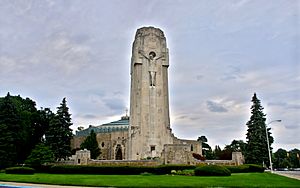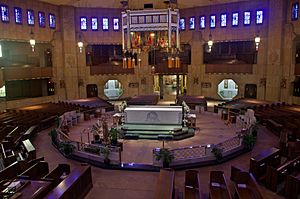National Shrine of the Little Flower Basilica facts for kids
Quick facts for kids National Shrine of the Little Flower Basilica |
|
|---|---|
 |
|
| Location | Royal Oak, Michigan, U.S. |
| Denomination | Catholic (Latin Rite) |
| Architecture | |
| Architect(s) | Henry J. McGill |
| Style | Art Deco |
| Years built | 1931–1936 |
| Administration | |
| Archdiocese | Archdiocese of Detroit |
The National Shrine of the Little Flower Basilica is a special Catholic church located in Royal Oak, Michigan. It's known as a national shrine, which means it's a very important place for Catholics. The church building is famous for its cool and fancy zig-zag Art Deco style. It was built in two main parts between 1931 and 1936.
This church is part of the Archdiocese of Detroit. Its construction was paid for by money raised from the radio shows of Father Charles Coughlin. He broadcast his shows from the church's tower in the 1930s.
History of the Shrine
The church is named after Saint Thérèse of Lisieux, who was also called "the Little Flower." The first church building was put up in 1926 in an area that was mostly Protestant. It was founded in 1925, a year before building began. Soon after the church opened, a group of people burned a cross in front of it.
The original wooden church was destroyed by a fire on March 17, 1936. The building you see today started being built in 1931 and was finished in 1936. The fire made them finish the new building faster. It was designed by architect Henry J. McGill and used a lot of copper and stone.
On January 31, 2015, Pope Francis gave the Shrine a special title: a minor basilica. This means it's a church with special importance.
Leaders of the Church
Here are some of the priests who have led the church over the years:
- Fr. Charles Coughlin (1925–1966)
- Fr. James L. Hayes (1966–1974)
- Fr. Edward A. Belczak (1975–1980)
- Fr. Edward J. Prus (1975–1987)
- Fr. Edward Haggerty (1987–1990)
- Msgr. John Gordon (1990–1991)
- Msgr. Alexander Joseph Brunett (1991–1994)
- Msgr. John Nienstedt (1994–1996)
- Msgr. William Easton (1996–2013)
- Fr. Robert Joseph Fisher (2014–2016)
- Msgr. Robert J. McClory (2016–2020)
- Fr. Joseph Horn (2020–2023)
- Fr. John Bettin (2023–present)
Church Design and Art
One of the most striking parts of the church is the Charity Crucifixion Tower. This tall Art Deco tower, finished in 1931, has amazing sculptures by Rene Paul Chambellan. A huge figure of Christ on the cross, about 28 feet tall, is on the side facing Woodward Avenue. This sculpture was carved by Enrico (Harry) Liva. It was built to be a "cross they could not burn," showing strength and faith.
The tower has windows inside the crucifix that can light up. At the top corners, you can see symbols of the Four Evangelists. Below the feet of Christ are carvings of the Seven Last Words from the Cross. There's also a doorway with "Charity" and "Christ Crucified" carved above it. Around the door, you can see pictures of things related to the Passion, which is about Jesus's suffering. This doorway leads to a small balcony that can be used as a pulpit for speaking.
On the front of the tower, there are carvings of Archangels like Jophiel, Raphael, Michael, Gabriel, and Uriel. Near the pulpit, there are figures of John the Apostle and the Virgin Mary on one side, and a Roman Centurion and Mary Magdalene on the other. Across from the crucifix, a sculpture of Saint Thérèse of Lisieux is carved into the wall. This sculpture was also made by Rene Paul Chambellan.
Behind the tower, doors lead to a large chapel that connects the tower to the main church. The altar of this chapel is at the base of the tower. The main seating area, called the nave, is shaped like an octagon and can hold 3,000 people on two levels. The altar is in the center.
The main church building is made of granite and limestone. It has beautiful sculptures inside and out by Corrado Parducci, including a lectern (a stand for reading) and Stations of the Cross (pictures showing Jesus's journey to the cross). There are also hand-painted murals by Beatrice Wilczynski. On the outside walls, you can find stones carved with the names and official flowers of each of the states. The octagon-shaped baptismal font, used for baptisms, was designed by Robert Rambusch and Mario Agustin Locsin y Montenegro.
In 1998, the United States Bishops' Conference officially named this site a national shrine.
More to Explore
- List of places named after St. Thérèse of Lisieux
See also
 In Spanish: Basílica del Santuario Nacional de la Pequeña Flor (Royal Oak) para niños
In Spanish: Basílica del Santuario Nacional de la Pequeña Flor (Royal Oak) para niños




